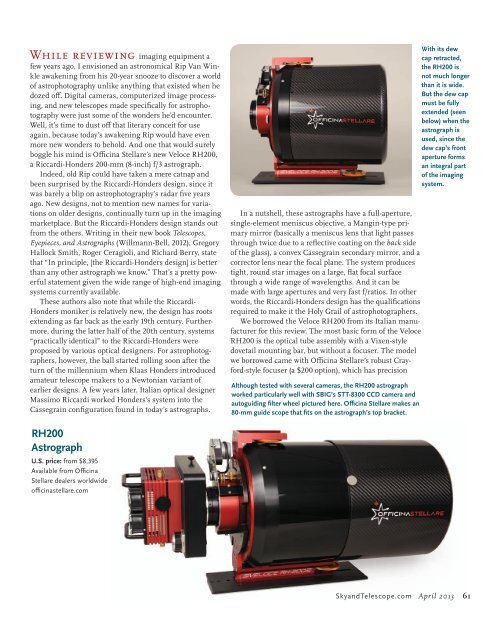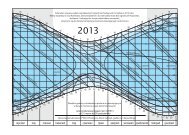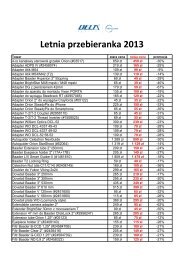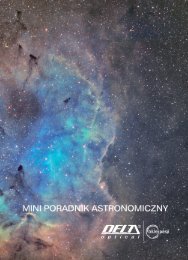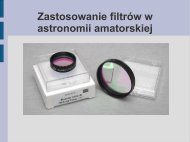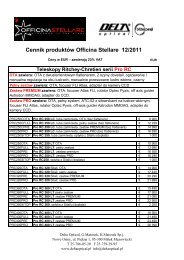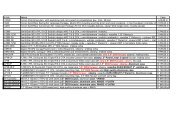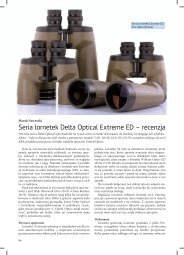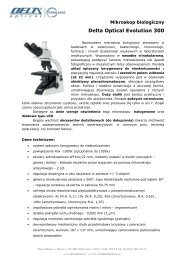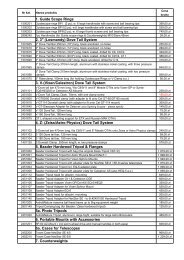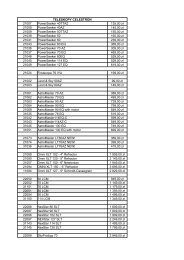Officina Stellare's Veloce RH200 Astrograph - Teleskop-Express
Officina Stellare's Veloce RH200 Astrograph - Teleskop-Express
Officina Stellare's Veloce RH200 Astrograph - Teleskop-Express
Create successful ePaper yourself
Turn your PDF publications into a flip-book with our unique Google optimized e-Paper software.
While reviewing<br />
imaging equipment a<br />
few years ago, I envisioned an astronomical Rip Van Winkle<br />
awakening from his 20-year snooze to discover a world<br />
of astrophotography unlike anything that existed when he<br />
dozed off. Digital cameras, computerized image processing,<br />
and new telescopes made specifically for astrophotography<br />
were just some of the wonders he’d encounter.<br />
Well, it’s time to dust off that literary conceit for use<br />
again, because today’s awakening Rip would have even<br />
more new wonders to behold. And one that would surely<br />
boggle his mind is <strong>Officina</strong> Stellare’s new <strong>Veloce</strong> <strong>RH200</strong>,<br />
a Riccardi-Honders 200-mm (8-inch) f/3 astrograph.<br />
Indeed, old Rip could have taken a mere catnap and<br />
been surprised by the Riccardi-Honders design, since it<br />
was barely a blip on astrophotography’s radar five years<br />
ago. New designs, not to mention new names for variations<br />
on older designs, continually turn up in the imaging<br />
marketplace. But the Riccardi-Honders design stands out<br />
from the others. Writing in their new book Telescopes,<br />
Eyepieces, and <strong>Astrograph</strong>s (Willmann-Bell, 2012), Gregory<br />
Hallock Smith, Roger Ceragioli, and Richard Berry, state<br />
that “In principle, [the Riccardi-Honders design] is better<br />
than any other astrograph we know.” That’s a pretty powerful<br />
statement given the wide range of high-end imaging<br />
systems currently available.<br />
These authors also note that while the Riccardi-<br />
Honders moniker is relatively new, the design has roots<br />
extending as far back as the early 19th century. Furthermore,<br />
during the latter half of the 20th century, systems<br />
“practically identical” to the Riccardi-Honders were<br />
proposed by various optical designers. For astrophotographers,<br />
however, the ball started rolling soon after the<br />
turn of the millennium when Klaas Honders introduced<br />
amateur telescope makers to a Newtonian variant of<br />
earlier designs. A few years later, Italian optical designer<br />
Massimo Riccardi worked Honders’s system into the<br />
Cassegrain configuration found in today’s astrographs.<br />
In a nutshell, these astrographs have a full-aperture,<br />
single-element meniscus objective, a Mangin-type primary<br />
mirror (basically a meniscus lens that light passes<br />
through twice due to a reflective coating on the back side<br />
of the glass), a convex Cassegrain secondary mirror, and a<br />
corrector lens near the focal plane. The system produces<br />
tight, round star images on a large, flat focal surface<br />
through a wide range of wavelengths. And it can be<br />
made with large apertures and very fast f/ratios. In other<br />
words, the Riccardi-Honders design has the qualifications<br />
required to make it the Holy Grail of astrophotographers.<br />
We borrowed the <strong>Veloce</strong> <strong>RH200</strong> from its Italian manufacturer<br />
for this review. The most basic form of the <strong>Veloce</strong><br />
<strong>RH200</strong> is the optical tube assembly with a Vixen-style<br />
dovetail mounting bar, but without a focuser. The model<br />
we borrowed came with <strong>Officina</strong> Stellare’s robust Crayford-style<br />
focuser (a $200 option), which has precision<br />
Although tested with several cameras, the <strong>RH200</strong> astrograph<br />
worked particularly well with SBIG’s STT-8300 CCD camera and<br />
autoguiding filter wheel pictured here. <strong>Officina</strong> Stellare makes an<br />
80-mm guide scope that fits on the astrograph’s top bracket.<br />
With its dew<br />
cap retracted,<br />
the <strong>RH200</strong> is<br />
not much longer<br />
than it is wide.<br />
But the dew cap<br />
must be fully<br />
extended (seen<br />
below) when the<br />
astrograph is<br />
used, since the<br />
dew cap’s front<br />
aperture forms<br />
an integral part<br />
of the imaging<br />
system.<br />
<strong>RH200</strong><br />
<strong>Astrograph</strong><br />
U.S. price: from $8,395<br />
Available from <strong>Officina</strong><br />
Stellare dealers worldwide<br />
officinastellare.com<br />
SkyandTelescope.com April 2013 61


